president
 I’m not sure why it is that every president “needs” a pet. Nevertheless, it seems that it is expected, and the “first dog” seems to be the most common choice of pet. Dogs are the most commonly talked about pets in the White House…in recent years anyway. The fact is that ever since George Washington, there has been a myriad of different animals that earned the title of presidential pet or first pet. Some of the more manageable animals to come under the care of the president were cats, horses, donkeys, cows, goats, and hamsters. Oddly, there were also the more “unique” animals that lived in the White House too, including, and often only temporarily, bobcats, raccoons, lions, tigers, and bears, if you can believe it.
I’m not sure why it is that every president “needs” a pet. Nevertheless, it seems that it is expected, and the “first dog” seems to be the most common choice of pet. Dogs are the most commonly talked about pets in the White House…in recent years anyway. The fact is that ever since George Washington, there has been a myriad of different animals that earned the title of presidential pet or first pet. Some of the more manageable animals to come under the care of the president were cats, horses, donkeys, cows, goats, and hamsters. Oddly, there were also the more “unique” animals that lived in the White House too, including, and often only temporarily, bobcats, raccoons, lions, tigers, and bears, if you can believe it.
One of the more common kind of animals was the variety of birds that have worn the title pf presidential pet. Birds, such as turkeys, mockingbirds, parakeets, and several other species of parrot and songbird have been the companions of past presidents and their families. One of the presidents that had a bird was Andrew Jackson, the seventh president, who owned a variety of pets, among them, an African grey parrot named Poll that he had purchased for his wife, Rachel. Unfortunately, had very little influence on Poll, because she died of a heart attack not long after his election in 1828. Because of Rachel’s untimely death, and unlike other presidential parrots, Poll took on some of Jackson’s more unbecoming characteristics. To put it mildly, Andrew Jackson was  an exceptionally volatile individual who often disregarded formality. On the one hand, Jackson’s character helped him to actually survive an assassination attempt and to win the Battle of New Orleans. Both of these made him quite popular, even though the treaty that followed the battle, was almost pointless, and so the battle was viewed much the same. On the other hand, as both a general and later president, Jackson used every tool at his disposal to crush indigenous sovereignty. He really had no use for the Native Americans, or at least not for their rights as a sovereign nation. In fact, his actions both directly and indirectly caused the deaths of thousands of Native Americans.
an exceptionally volatile individual who often disregarded formality. On the one hand, Jackson’s character helped him to actually survive an assassination attempt and to win the Battle of New Orleans. Both of these made him quite popular, even though the treaty that followed the battle, was almost pointless, and so the battle was viewed much the same. On the other hand, as both a general and later president, Jackson used every tool at his disposal to crush indigenous sovereignty. He really had no use for the Native Americans, or at least not for their rights as a sovereign nation. In fact, his actions both directly and indirectly caused the deaths of thousands of Native Americans.
Nevertheless, where Poll was concerned, the loss of Rachel and Jacksons crude talk led to a number of problems later on. Poll was therefore almost constantly exposed to the already foul-mouthed and hot-tempered president. I don’t suppose all that matter very much to Jackson, who was obviously used to his own way of speaking, but on the day of Jackson’s funeral, it was decided by Jackson, that Poll was to be in attendance, 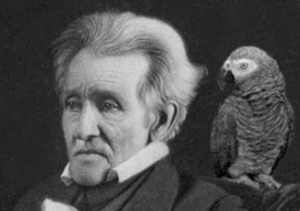 along with the grieving spectators. I can only imagine the guests, especially of that era, Jackson passed away on June 8, 1845, when after possibly being unnerved by the number of people, Poll proceeded to shock all of the guests when he began to exclaim all sorts of profanity and otherwise inappropriate language. According to witnesses, Poll’s outbursts were so disruptive that the bird had to be escorted away from the proceedings. Even after his departure, I’m sure that the prim and proper ladies and gentlemen had to take a moment to compose themselves before the funeral could continue. I guess it just goes to show that sometimes, more than just our children are listening to every word we say.
along with the grieving spectators. I can only imagine the guests, especially of that era, Jackson passed away on June 8, 1845, when after possibly being unnerved by the number of people, Poll proceeded to shock all of the guests when he began to exclaim all sorts of profanity and otherwise inappropriate language. According to witnesses, Poll’s outbursts were so disruptive that the bird had to be escorted away from the proceedings. Even after his departure, I’m sure that the prim and proper ladies and gentlemen had to take a moment to compose themselves before the funeral could continue. I guess it just goes to show that sometimes, more than just our children are listening to every word we say.
 Long before James Madison became out fourth President of the United States, he served in a number of other positions. Early on, Madison emerged as an important leader in the House of Representatives and was a close adviser to President George Washington. While many of the early leaders of our nation understood and were prepared to fight for our freedom, they weren’t necessarily eloquent speakers or writers, but then again, many politicians today also have speech writers. I guess each felt the need to work on the important things, and delegate the rest. Since James Madison was well-known as an excellent writer, President Washington asked him to write a letter to Congress for him expressing that he was excited to work with them. Washington wasn’t the greatest wordsmith, and Madison was an excellent writer, so he had Madison do the job.
Long before James Madison became out fourth President of the United States, he served in a number of other positions. Early on, Madison emerged as an important leader in the House of Representatives and was a close adviser to President George Washington. While many of the early leaders of our nation understood and were prepared to fight for our freedom, they weren’t necessarily eloquent speakers or writers, but then again, many politicians today also have speech writers. I guess each felt the need to work on the important things, and delegate the rest. Since James Madison was well-known as an excellent writer, President Washington asked him to write a letter to Congress for him expressing that he was excited to work with them. Washington wasn’t the greatest wordsmith, and Madison was an excellent writer, so he had Madison do the job.
James Madison was excited to be a part of this first administration and wanted to give it his very best effort. So, in one of his first official actions under President George Washington, Madison wrote a beautiful letter to Congress. Congress was very impressed with the “letter from President Washington” and wanted to impress him with a letter of their own. So, naturally, they chose the best qualified person to write a response to President Washington…you guessed it, James Madison. So, Madison wrote a response to the original letter, that he wrote, saying that Congress was also very excited to be working with the president.
Under normal circumstances, you would expect that the two letters would be the end of the matter, and the new administration would proceed to get down to business. You would be wrong. President Washington decided to send a response to the response, and to make matters even more ludicrous, Congress sent a response to 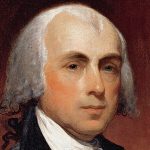 that response as well. As it turns out, and of course, Madison wrote those other letters too. So, all in all, Madison had a whole little conversation with himself by mail in the form of four separate letters. Of course, he still represented the president and congress, but it’s quite likely that no one actually read the letters before they were sent, or at least didn’t really read them carefully…not until the received them anyway. Nevertheless, James Madison wanted to do the very best job he could for both President Washington and for Congress. If he had not don’t an exceptional job, they would not ask for his help again, and his career could have been over. Somehow, I don’t think that was his real motive in writing the excellent letters. I think he wanted to be of good service to the president. Still in the end, Madison’s first official act for President Washington was to write four letters…to himself.
that response as well. As it turns out, and of course, Madison wrote those other letters too. So, all in all, Madison had a whole little conversation with himself by mail in the form of four separate letters. Of course, he still represented the president and congress, but it’s quite likely that no one actually read the letters before they were sent, or at least didn’t really read them carefully…not until the received them anyway. Nevertheless, James Madison wanted to do the very best job he could for both President Washington and for Congress. If he had not don’t an exceptional job, they would not ask for his help again, and his career could have been over. Somehow, I don’t think that was his real motive in writing the excellent letters. I think he wanted to be of good service to the president. Still in the end, Madison’s first official act for President Washington was to write four letters…to himself.
 There have been many firsts that our United States Presidents have been able to celebrate. One such first was “the first president to ride in a helicopter.” That particular first honor went to a well-known general turned president…Dwight D Eisenhower. On July 12, 1957, President Eisenhower became that first United States president to fly in a helicopter when a United States Air Force H-13J-BF Sioux, serial number 57-2729 (c/n 1576). The helicopter was piloted by Major Joseph E Barrett, USAF. It departed the White House lawn for Camp David, the presidential retreat in the Catoctin Mountains of Maryland. Of course, no presidential trip happens without a Secret Service agent, also on board. On that same day, a second H-13J, 57-2728 (c/n 1575), followed the first, this one carrying President Eisenhower’s personal physician and a second Secret Service agent.
There have been many firsts that our United States Presidents have been able to celebrate. One such first was “the first president to ride in a helicopter.” That particular first honor went to a well-known general turned president…Dwight D Eisenhower. On July 12, 1957, President Eisenhower became that first United States president to fly in a helicopter when a United States Air Force H-13J-BF Sioux, serial number 57-2729 (c/n 1576). The helicopter was piloted by Major Joseph E Barrett, USAF. It departed the White House lawn for Camp David, the presidential retreat in the Catoctin Mountains of Maryland. Of course, no presidential trip happens without a Secret Service agent, also on board. On that same day, a second H-13J, 57-2728 (c/n 1575), followed the first, this one carrying President Eisenhower’s personal physician and a second Secret Service agent.
While that first flight was really a pleasure ride, the main purpose of the helicopter was to rapidly move the 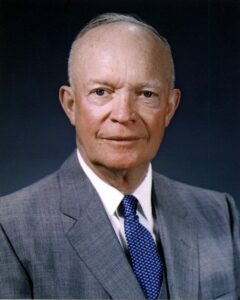 president from the White House to Andrews Air Force Base where his Lockheed VC-121E Constellation, Columbine III, would be standing by. This was intended to be a way of escape to Andrews or to other secure facilities in case of an emergency. Major Barrett was selected as the pilot because of his extensive experience as a combat pilot. They needed someone who was a capable pilot under pressure, a skill that Major Barrett proved he possessed during World War II, when he flew the B-17 Flying Fortress four-engine heavy bomber. Major Barrett was credited with carrying out a helicopter rescue 70 miles behind enemy lines during the Korean War. For his heroics, he was awarded the Silver Star.
president from the White House to Andrews Air Force Base where his Lockheed VC-121E Constellation, Columbine III, would be standing by. This was intended to be a way of escape to Andrews or to other secure facilities in case of an emergency. Major Barrett was selected as the pilot because of his extensive experience as a combat pilot. They needed someone who was a capable pilot under pressure, a skill that Major Barrett proved he possessed during World War II, when he flew the B-17 Flying Fortress four-engine heavy bomber. Major Barrett was credited with carrying out a helicopter rescue 70 miles behind enemy lines during the Korean War. For his heroics, he was awarded the Silver Star.
Not only was the helicopter a great way to quickly secure the president, but that original pilot was the perfect person to make sure that the president was safely transferred to that secure location. The President of the United States is always in a degree of danger. It goes with the territory I suppose. It is the job of his security details is to make sure that no threats are ever able to be carried out. They are very loyal and would die to protect the president.
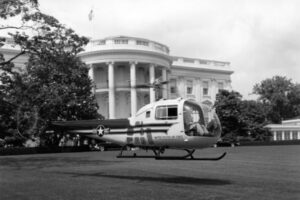
The Bell Helicopter Company of Fort Worth, Texas, manufactured two of the helicopters. They were delivered to the Air Force at Wright-Patterson Air Force Base on March 29, 1957. The two presidential H-13Js were nearly identical to the commercial Bell Model 47J Ranger. They were capable of carrying a pilot and up to three passengers. An enclosed cabin was built on a tubular steel framework with all-metal semi-monocoque tail boom. The main rotor was 37 feet 2 inches in diameter and tail rotor was 5 feet 10.13 inches, making the helicopter an overall length of 43 feet 3¾ inches with rotors turning. It stood 9 feet 8 inches and weighed 2,800 pounds.

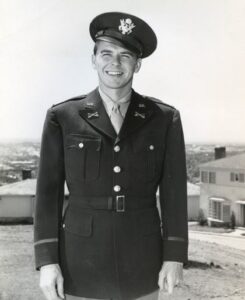 It’s almost unheard of to have a cavalry officer suddenly completely move in a different direction, and become an Army Air Force officer, but on May 15, 1942, Lieutenant Ronald Reagan, who had enlisted in the Army in 1935, was a cavalry officer at the time, applied for reassignment to the Army Air Force. Switching from the Army to the Army Air Force, while not unheard of, was an unusual event, especially in that no one really expected to be in the service for an extended period of time. For the most part, during World War II, it had been agreed upon that the soldier would be returned to the United States by February 1946. That said, it didn’t always make sense to make such a big move as switching branches of service.
It’s almost unheard of to have a cavalry officer suddenly completely move in a different direction, and become an Army Air Force officer, but on May 15, 1942, Lieutenant Ronald Reagan, who had enlisted in the Army in 1935, was a cavalry officer at the time, applied for reassignment to the Army Air Force. Switching from the Army to the Army Air Force, while not unheard of, was an unusual event, especially in that no one really expected to be in the service for an extended period of time. For the most part, during World War II, it had been agreed upon that the soldier would be returned to the United States by February 1946. That said, it didn’t always make sense to make such a big move as switching branches of service.
Then Lieutenant Ronald Reagan was, at least at that time, mostly looking to have a career in acting, and it was here that he would eventually put his thespian background to use making World War II propaganda films. Once his transfer was approved on June 9, 1942, Reagan was given a job as a public relations officer for the First Motion Picture Unit. The First Motion Picture Unit (FMPU) produced military training, morale, and propaganda films to aid the war effort. FMPU released Frank Capra’s “Why We Fight” series and a documentary of the bomber Memphis Belle, the crew of which completed a standard-setting 25 bombing missions in Europe for the first time. No other plane and crew, to that date, had managed to fly the 25 missions and make it back. War was a dangerous lifestyle for the Allied planes. The films were screened on domestic training grounds and in troop camps overseas as well as in movie theaters at home. The Memphis Belle documentary gave people hope that it could be done, and all was not lost.
Reagan did several other films, one of which, “Air Force,” which was later renamed “Beyond the Line of Duty.” That movie told the true story of the heroic feats of aviator Shorty Wheliss and his crew. Reagan narrated the film. While the documentary was originally intended simply to promote investment in war bonds, it won an 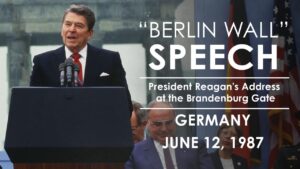
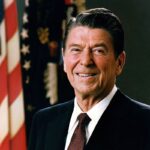 Academy Award in 1943 for best short subject. Reagan went on to narrate or star in three more shorts for FMPU including “For God and Country,” “Cadet Classification,” and “The Rear Gunner.” Reagan also appeared as Johnny Jones in the 1943 full-length musical film This is the Army. Of course, as we all know, Ronald Reagan’s true destiny was to become one of our greatest presidents of all time and a very brave man.
Academy Award in 1943 for best short subject. Reagan went on to narrate or star in three more shorts for FMPU including “For God and Country,” “Cadet Classification,” and “The Rear Gunner.” Reagan also appeared as Johnny Jones in the 1943 full-length musical film This is the Army. Of course, as we all know, Ronald Reagan’s true destiny was to become one of our greatest presidents of all time and a very brave man.

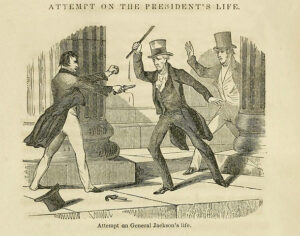 Over the course of American history, several presidents have been assassinated, and several others have survived attempted assassinations. Some were quickly treated, and others were not where the would-be assassin thought they were going to be. Still, Andrew Jackson, the seventh US president better known as “Old Hickory” was, without doubt, the most amazing one. and for good reason, as one would-be assassin found out.
Over the course of American history, several presidents have been assassinated, and several others have survived attempted assassinations. Some were quickly treated, and others were not where the would-be assassin thought they were going to be. Still, Andrew Jackson, the seventh US president better known as “Old Hickory” was, without doubt, the most amazing one. and for good reason, as one would-be assassin found out.
On January 30, 1835, Richard Lawrence came up to the 67-year-old Jackson, as he left a congressional funeral and pulled a pistol on him. I’m sure he thought a 67-year-old man was going to be an easy target, but when he pulled the trigger, the gun misfired. While having his gun misfire was…inconvenient, Lawrence also found out that a 67-year-old man is not necessarily a weak, old man. A furious Jackson began beating the man viciously with his cane in retaliation. Then, while trying to dodge the cane wielded by Jackson, Lawrence managed to pull a second gun from his jacket and pull the trigger. I don’t know how, but Lawrence had to be either the unluckiest assassin, or a totally inept gunman, because the second gun also jammed. By this point, Jackson’s aides were able to wrestle Lawrence away and into custody. Jackson was unharmed. 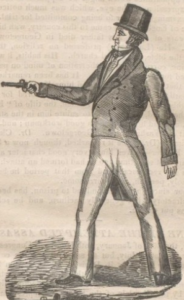
Jackson became convinced that the attempt was made at the behest of his political enemies, even though all evidence pointed to Lawrence being a mentally unstable lone wolf. I rather think I might agree with Jackson on this one, because politics can be a deadly career to get into. Jackson spent the rest of his presidency worried about another attack, while his vice president, Martin Van Buren, started carrying two loaded pistols with him into the Senate.
You can take away any opinion on this matter that you want to, but I have my own. I find it amazing that Jackon had the wherewithal to “pull” his cane on his would-be assassin, but how often to you see two different guns misfire in the commission of the same assassination. I see that situation as nothing but God. Jackson was the recipient of a double miracle. If either of those gun shots would have connected to their mark, he would surely have been dead. This was not a sniper shooter, but rather, a close-range shooter, and would have meant instant death. No, this man was divinely protected, and that’s all there is to it.
 While most people look back on their childhood with fond memories, most of us would say our childhood was probably typical for the era we lived in. Of course, not every childhood is perfect, and some can be absolutely horrible. President Abraham Lincoln was born on February 12, 1890, and spent his childhood years in Kentucky and Indiana. He personally summed up his childhood days on the frontier as “the short and simple annals of the poor.” While that is how Lincoln saw his childhood, he wasn’t the only one in that situation. The hardships he endured there as a child weren’t unique. Frontier life was harsh for most families in the early 1800s. Living and working on the frontier was hard work. In fact, sometimes the people worked as hard as their oxen and horses. According to Lincoln, his earliest memories were of life on the farm in Kentucky where he moved in 1811 with his parents, Thomas and Nancy, and sister, Sarah. She was four years old, and Abraham was two years old. His parents had been married five years.
While most people look back on their childhood with fond memories, most of us would say our childhood was probably typical for the era we lived in. Of course, not every childhood is perfect, and some can be absolutely horrible. President Abraham Lincoln was born on February 12, 1890, and spent his childhood years in Kentucky and Indiana. He personally summed up his childhood days on the frontier as “the short and simple annals of the poor.” While that is how Lincoln saw his childhood, he wasn’t the only one in that situation. The hardships he endured there as a child weren’t unique. Frontier life was harsh for most families in the early 1800s. Living and working on the frontier was hard work. In fact, sometimes the people worked as hard as their oxen and horses. According to Lincoln, his earliest memories were of life on the farm in Kentucky where he moved in 1811 with his parents, Thomas and Nancy, and sister, Sarah. She was four years old, and Abraham was two years old. His parents had been married five years.
At Knob Creek, in Kentucky, the Lincoln family lived in a one-room cabin with a dirt floor. The place was very similar to the place where Lincoln was born a mere nine miles way near Hodgenville. Steep, heavily wooded hills rose on each side of the home. Nevertheless, things were “looking up” on the Knob Creek farm, because while the place was leased, Lincoln’s father planted corn and pumpkins on wide fields with rich soil on the 30-acre farm. From the little dirt-floor cabin on the road from Louisville to Nashville, the Lincoln family watched as the “world passed” by. Pioneers with fully loaded wagons, peddlers, local politicians, slaves, missionaries and soldiers returning from the War of 1812.
Abraham’s dad, Thomas Lincoln, who was stern and often domineering, put his son to work before he turned seven. Of course, if you ask me, seven-year-olds can help out, provided that they aren’t mistreated in the process. Abraham filled the wood box, brought water from the creek, weeded the garden, gathered grapes for wine and jelly, picked persimmons for beer making and planted pumpkin seeds.
Lincoln didn’t have many opportunities to go to school, as was common in those days in rural Kentucky. For the most part he was self-taught. Mostly, he and his sister sporadically attended ABC schools—so-called “blab” schools in which students repeated their teacher’s oral lessons aloud. Usually barefoot, Lincoln walked to the one-room schoolhouse, “a little log room about 15 feet square, with a fireplace at one side.”
Two years later, Abraham’s mother, Nancy Lincoln died in the remote wilderness—the first of Lincoln’s many family tragedies. Nancy was a good mother, and her passing was heartbreaking for the Lincoln children. Apparently, she had consumed milk tainted when cows ate poisonous white snakeroot…although, some believed the cause of death was tuberculosis. She was just 34 years old. Eleven-year-old Sarah now became the woman of the house, and all domestic duties fell to her. The Lincoln children’s lives were worse than ever. That winter, the motherless children and their 19-year-old orphan cousin lived dismally in that place.
It didn’t take Thomas long to decide that he needed a new wife, so Thomas Lincoln traveled to Elizabethtown, Kentucky, where he proposed to widow Sarah Bush Johnston, whom he had known since childhood. She accepted, provided Lincoln paid off her debts. On December 2, 1819, Thomas and Sarah married and later returned to Little Pigeon Creek, accompanied by her three children: Elizabeth, 13; Matilda, 10; and John, 9. Thomas’s new wife brought along furniture (including a walnut bureau valued at $50), cooking utensils and comfortable bedding…astonishing luxuries for her new stepchildren. She also brought several books, including the Bible and Aesop’s Fables, which she gifted to Abe. Things were looking up again in the Lincoln household. At his wife’s insistence, Thomas Lincoln installed a cabin floor and plastered cracks between logs. Instead of cornhusks, Abraham and his sister slept on a feather bed. The cramped conditions were no match for the love Sarah brught with her, and the family thrived. To make him look “more human,” Lincoln’s stepmother dressed up the poorly clad Abraham.
On the farm, Lincoln became skillful with an ax. But Thomas didn’t see the need for the reading his son loved. 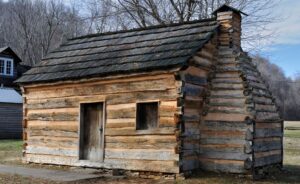 He wanted him to learn carpentry, but Abraham wasn’t interested, and the matter brought tension to the relationship. Sometimes the illiterate Thomas even reprimanded Abraham for reading instead of doing farm chores. Thankfully, Sarah Bush Lincoln persuaded her husband to allow their son to read and study. “At first, he was not easily reconciled to it,” she recalled, “but finally he too seemed willing to encourage him to a certain extent.” The bond between stepmother and stepson grew. Sarah Bush Lincoln recalled years later, “Abe was the best boy I ever saw.” I think we would a have to agree, he was not just a good boy, but a great man and a great president.
He wanted him to learn carpentry, but Abraham wasn’t interested, and the matter brought tension to the relationship. Sometimes the illiterate Thomas even reprimanded Abraham for reading instead of doing farm chores. Thankfully, Sarah Bush Lincoln persuaded her husband to allow their son to read and study. “At first, he was not easily reconciled to it,” she recalled, “but finally he too seemed willing to encourage him to a certain extent.” The bond between stepmother and stepson grew. Sarah Bush Lincoln recalled years later, “Abe was the best boy I ever saw.” I think we would a have to agree, he was not just a good boy, but a great man and a great president.
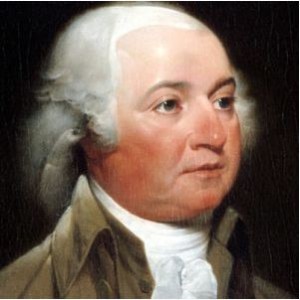 His Elective Majesty…sounds almost laughable, but it was almost the proper way to address the President of the United States, a fact that some presidents would probably have liked very much. Some presidents have tried to “rule” as a king would have, so they figure, why not buy in whole heartedly. One such president, who in fact made the original suggestion of title, was none other than, at the time, Vice President John Adams. The idea came from the fact that other heads of state are known by honorifics such as “His Excellency” and such, but United States presidents are only ever Mr President…or “sir” in a pinch. I’m sure that John Adams already had his sights set on becoming president at some point, and the second president of the United States seemed as good a time to run as any…or maybe he liked his own idea very much.
His Elective Majesty…sounds almost laughable, but it was almost the proper way to address the President of the United States, a fact that some presidents would probably have liked very much. Some presidents have tried to “rule” as a king would have, so they figure, why not buy in whole heartedly. One such president, who in fact made the original suggestion of title, was none other than, at the time, Vice President John Adams. The idea came from the fact that other heads of state are known by honorifics such as “His Excellency” and such, but United States presidents are only ever Mr President…or “sir” in a pinch. I’m sure that John Adams already had his sights set on becoming president at some point, and the second president of the United States seemed as good a time to run as any…or maybe he liked his own idea very much.

Apparently, thinking that the office of the President of the United States needed a title with more grandeur, Adams suggested that a president should be referred to as either “His Elective Majesty,” “His Mightiness,” or the slightly excessive “His Highness, the President of the United States of America and the Protector of their Liberties.” Just imagine any of those ideas. Every one of them make me giggle. Just take a moment to say (out loud) those titles in connection with the president…any president. With some presidents, any one of these titles is hilarious, and I’ll let you to decide to whom that statement applies, because these days we all have very specific opinions on the matter.
In those days, Washington was very aware of public fear about their newly won democracy slipping back into a 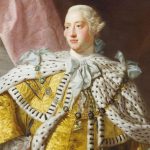 monarchy. They didn’t want this new nation to be too similar to England. They didn’t want this newly free nation to become once again ruled by a different kind of monarchy. So, they refused to allow the president to be titled as anything other than “The President of the United States.” They were right, of course, because the United States is not a “spin-off” of England…like England 2.0. The United States is a very unique nation…unlike any other, before her or after her. This nation was founded by people who refused to be told what to believe anymore. That is why they left England, where they were forced to live under a “state religion.” The nation was founded as “one nation, under God.” We would not have a king, because Jesus was our King of kings. We couldn’t give that title to a mere man.
monarchy. They didn’t want this new nation to be too similar to England. They didn’t want this newly free nation to become once again ruled by a different kind of monarchy. So, they refused to allow the president to be titled as anything other than “The President of the United States.” They were right, of course, because the United States is not a “spin-off” of England…like England 2.0. The United States is a very unique nation…unlike any other, before her or after her. This nation was founded by people who refused to be told what to believe anymore. That is why they left England, where they were forced to live under a “state religion.” The nation was founded as “one nation, under God.” We would not have a king, because Jesus was our King of kings. We couldn’t give that title to a mere man.
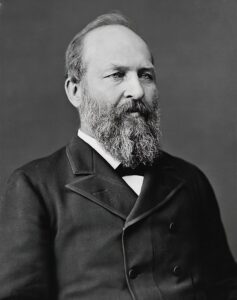 In the history of the United States, 4 presidents have been assassinated. Of course the ones we remember the most are Abraham Lincoln and John F Kennedy. The other two were William McKinley and James Garfield. With Lincoln and Kennedy, death was quick, even though with Lincoln it took until the next day. With McKinley, death came 7 days after he was shot, but with Garfield, death needn’t have come at all.
In the history of the United States, 4 presidents have been assassinated. Of course the ones we remember the most are Abraham Lincoln and John F Kennedy. The other two were William McKinley and James Garfield. With Lincoln and Kennedy, death was quick, even though with Lincoln it took until the next day. With McKinley, death came 7 days after he was shot, but with Garfield, death needn’t have come at all.
President James A Garfield had served as the president for just four months when he was shot on July 2, 1881, by Charles Guiteau in Washington DC. Guiteau had been stalking the president for about a month, and he shot him in the arm and the back. Guiteau wasn’t much of a shot I guess. Garfield didn’t die instantly, and in fact he didn’t die for 11 weeks. In the end, it wasn’t the wounds that caused his death, but rather that the wounds became infected which claimed the president’s life in the end. Had the doctors of that age known more about infection, I believe Garfield might have lived. Infection always comes from exposure to a bacteria or virus. Yes, it could have been introduced by the bullets, but with the proper treatment, the infection could also have been thwarted. Of course, I don’t know if President Garfield would have been able to walk, or move in any other way, because I don’t know how bad the wound in his back was. Nevertheless, a would that took 11 weeks to kill the man, could not have been an infection that could not be healed. Of course, I’m no  doctor, but then modern medicine has many more tools in it’s belt now than it did then. Ironically, when you think about it Garfield was not the only one of the assassinated presidents who faced exposure and lost. The others were exposed to their assassins bullet, a sad but true fact. It’s just that Garfield suffered a much longer length of time than the others…and that is truly awful.
doctor, but then modern medicine has many more tools in it’s belt now than it did then. Ironically, when you think about it Garfield was not the only one of the assassinated presidents who faced exposure and lost. The others were exposed to their assassins bullet, a sad but true fact. It’s just that Garfield suffered a much longer length of time than the others…and that is truly awful.
Apparently, Guiteau was angry because the president didn’t appoint him to the office he desired. That is an insane reason to kill a man, and Guiteau must have been a man who could not control his own emotions…sadly. While the assassinations of Lincoln, Kennedy, and McKinley are still steeped in conspiracy theories and political ideology, Guiteau’s motivations were simple…egomania, delusions of grandeur, and the belief that God had willed him to “remove” Garfield from office. Guiteau failed to become the “great man” he was striving to be, and after being convicted of murder, Guiteau was sentenced to death and was hanged in 1882.
 When I think of the assassination of President Abraham Lincoln, I think of John Wilkes Booth shooting the president at the Ford Theater. I don’t think about the assassination being a part of a conspiracy, but in fact, it was. It makes sense, I guess, because it isn’t even logical that someone could simply walk into the Ford Theater and to the President’s box and shoot him. Someone had to tell Booth where the president was going to be. Someone had to clear the way for Booth to get in. Someone had to remove more than just a president. This was a plot to change history.
When I think of the assassination of President Abraham Lincoln, I think of John Wilkes Booth shooting the president at the Ford Theater. I don’t think about the assassination being a part of a conspiracy, but in fact, it was. It makes sense, I guess, because it isn’t even logical that someone could simply walk into the Ford Theater and to the President’s box and shoot him. Someone had to tell Booth where the president was going to be. Someone had to clear the way for Booth to get in. Someone had to remove more than just a president. This was a plot to change history.
Lincoln conspirator Mary Surratt, who was born Mary Elizabeth Jenkins in 1823, was from Maryland. Before her acts of treason, Mary married John Harrison Surratt in 1840, when she was 17. They planed a life together an began buying massive amounts of land near Washington. Together, she and her husband had three children…John Jr, Isaac, Anna. Then After her husband’s death in 1864, when she was just 41, Mary moved to Washington DC, on High Street. To make some money, Mary rented part of her property…a tavern that her husband had built, to a man named John Lloyd, who was a retired police officer.
John Jr, Mary’s eldest son, met John Wilkes Booth during his time as a Confederate spy. Because of this connection, when Booth was plotting Lincoln’s assassination with his co-conspirators, he felt perfectly at home in Mary Surratt’s DC residence, which had by this time, become a boardinghouse. As plans progresses Mary Surratt also became involved with the shooting of Abraham Lincoln, through these men. She even asked Lloyd to help. Her request was that he have some “shooting-irons” ready for some men that would stop by later that night…the night that they murdered Abraham Lincoln. Although drunk, Lloyd was able to provide testimony of the appearance of Booth and a co-conspirator at Mary’s tavern. For her involvement, Mary Surratt was sentenced to death, she was the first woman to be executed by the United States Government. She asked of her executioners only to, “not let her fall” in a very small voice, but as she was hanged on July 7, 1865, her request was not honored.
Lewis Powell (some accounts say Paine) was nicknamed Doc as a child for his love of nursing animals back to health. Powell’s part in the conspiracy was to assassinate Secretary of State Seward. Seward was at home sick in bed the night of the assassination. That should have made his job easier. Powell gained entry to the home claiming to have medicine for Seward, but when he entered Seward’s room, he found Seward’s son, Franklin. They got into a scuffle when Powell refused to hand over the medicine. Powell beat Franklin so badly that he 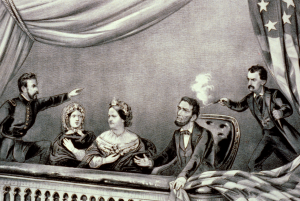
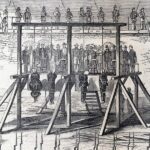 was in a coma for sixty days. He also stabbed Seward’s body guard before stabbing Steward several times. He was pulled off the Secretary by the body guard and two other members of the household. Seward survived, and Powell hid in a cemetery overnight. He was caught when he returned to Mary Surratt’s while she was being questioned by investigators. Powell attempted suicide while waiting for a verdict. He was convicted and hanged on July 7, 1865.
was in a coma for sixty days. He also stabbed Seward’s body guard before stabbing Steward several times. He was pulled off the Secretary by the body guard and two other members of the household. Seward survived, and Powell hid in a cemetery overnight. He was caught when he returned to Mary Surratt’s while she was being questioned by investigators. Powell attempted suicide while waiting for a verdict. He was convicted and hanged on July 7, 1865.
David Herold accompanied Powell to Seward’s house. Herold waited outside with the getaway horses. After Lincoln was assassinated, Herold managed to escape DC that same night, and met up with Booth. He was caught with Booth on April 26. Despite his lawyers many attempts to convince the court his client was innocent, Herold was convicted and was hanged on July 7, 1865.
George Atzerodt was given the task of killing Vice President Johnson. He went to the hotel Johnson was staying at, but was too afraid to kill the vice president. He went to the hotel bar and began drinking, hoping to get his courage up to do his part. Instead, he got very drunk and spent the night wandering the streets of Washington DC. He was arrested after the bartender reported his strange questions the night before. Atzerodt was convicted and hanged on July 7, 1865.
Edman Spangler was at Ford’s Theater the night of the assassination. Witness testimonies were conflicting as to his role in covering up Booth’s escape, but he allegedly took down the man trying to catch Booth before he fled. Spangler was found guilty and sentenced to six years in prison. He was pardoned in 1869 by President Johnson…which is odd considering the group tried to kill him. Spangler died in 1875 on his farm in Maryland.
Samuel Arnold was not involved in the April 14 assassination attempts. However, he was involved in earlier plots to kidnap Lincoln, and was arrested for his connections to Booth. Arnold was convicted and sentenced to life in prison. He was pardoned by President Johnson in 1869. He died in 1906 from tuberculosis.
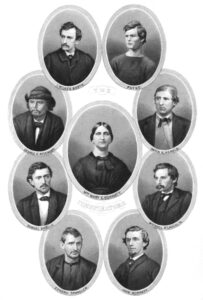
It is unclear what role Michael O’Laughlen played in the actual assassination attempts. He was surely a conspirator to the group’s plans. He voluntarily surrendered on April 17. O’Laughlen was convicted and sentenced to life in prison. He died from yellow fever two years into his sentence.
It is unclear what part, if any, Mary’s son, John Surratt Jr played in the events of April 14. He claims to have been in New York that night, but he escaped to Canada and an international manhunt ensued for him. After his mother’s execution in July, he escaped to England. He then traveled to Rome and joined the group of soldiers protecting the Pope. It was while visiting Alexandria, Egypt that he was finally recognized and sent back to the United States. Unlike the other co-conspirators, Surratt was tried by a civilian court. On August 10 the trial ended with a hung jury and the charges were dropped in 1868. He died from pneumonia in 1916, and was the last living person with ties to the assassination attempt.

 During World War II, transferring intel from the spies in France…the resistance, was difficult. To fly a plane through the anti-aircraft fire was dangerous, and often not successful. To send a spy on foot was not only something that would take far too long, not to mention the possibility of being caught. The intelligence community had to come up with a way to get the information to the generals and to the president quickly…and it had to be a way to succeed without massive loss of life.
During World War II, transferring intel from the spies in France…the resistance, was difficult. To fly a plane through the anti-aircraft fire was dangerous, and often not successful. To send a spy on foot was not only something that would take far too long, not to mention the possibility of being caught. The intelligence community had to come up with a way to get the information to the generals and to the president quickly…and it had to be a way to succeed without massive loss of life.
After much discussion, they happened on the idea of using homing pigeons to take messages back and forth between the spies, the resistance, and even the citizens of France. The idea was to drop the pigeons in a cage that was parachuted into the country. Once the pigeons were on the ground, the people were to write notes on small pieces of paper, place it in the canister attached to the pigeon’s leg, and release the bird to fly home. These pigeons were a huge help to the war effort, and were used in at least two wars.
Years later, a couple stumbled onto a capsule containing a cryptic note dated to either 1910 or 1916. Jade Halaoui was hiking in the fields near Alsace, France this September 2020. Ahead of him, he noticed something shiny. Upon further inspection, he found a small capsule partially buried in the ground and opened it. Inside was a note, written in German in cursive script by a Prussian military officer. Most likely the canister has been attached to a carrier pigeon, but never reached its destination. Halaoui and his partner, Juliette, took the artifact to the Linge Memorial Museum in Orbey.
A curator took a look at the canister and it’s note. He sat down at a table and delicately lifted the frail-looking slip of paper with tweezers. The note was very old, thin, and worn. It was written in spidery German cursive script. It was determined that the message was likely sent by a Prussian infantry officer via carrier pigeon around the onset of World War I. Dominique Jardy, curator at the Linge museum, told one reporter that the note was written in looping handwriting that is difficult to decipher, however, while the date clearly reads July 16…the year could be interpreted as 1910 or 1916. World War I took place between 1914 and 1918. With that in mind, it was concluded that the note was likely written 1916.
Jardy enlisted a German friend to help him translate the note. The note read in part: “Platoon Potthof receives fire as they reach the western border of the parade ground, platoon Potthof takes up fire and retreats after a while. In Fechtwald half a platoon was disabled. Platoon Potthof retreats with heavy losses.” The message, which was addressed to a senior officer. It appears that the infantryman was based in Ingersheim. The note refers to a military training ground, which lead Jardy to think that the note likely refers to a practice maneuver, not actual warfare. If this was the case, and the note was written in 1910, it could refer to a preparation for war. If it was written in 1916, this could have been training in anticipation of a long time of war.
Jardy mentioned that military officials typically sent multiple pigeons with the same message to ensure that crucial information reached its destination. One can only hope that is true, because if this was vital information, 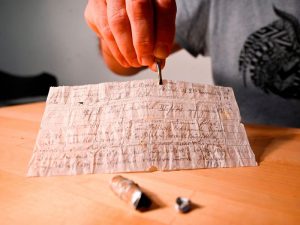
 and it did not get through, finding it now is unfortunately more than a century too late. Halaoui discovered the long-lost message just a few hundred yards from its site of origin, so Jardy suspects that this capsule slipped off the homing pigeon’s leg early in its journey. I hope that is true, because some of these pigeons were shot down. Others were caught by the hungry citizens and used for food, but some made it home and they were heroes of war too, because they brought important intel to the Allies.
and it did not get through, finding it now is unfortunately more than a century too late. Halaoui discovered the long-lost message just a few hundred yards from its site of origin, so Jardy suspects that this capsule slipped off the homing pigeon’s leg early in its journey. I hope that is true, because some of these pigeons were shot down. Others were caught by the hungry citizens and used for food, but some made it home and they were heroes of war too, because they brought important intel to the Allies.

